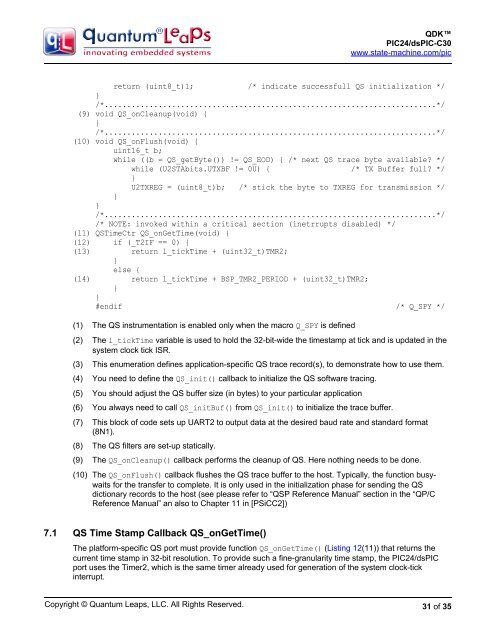QDK PIC24/dsPIC-C30 - Quantum Leaps
QDK PIC24/dsPIC-C30 - Quantum Leaps
QDK PIC24/dsPIC-C30 - Quantum Leaps
Create successful ePaper yourself
Turn your PDF publications into a flip-book with our unique Google optimized e-Paper software.
<strong>QDK</strong><br />
<strong>PIC24</strong>/<strong>dsPIC</strong>-<strong>C30</strong><br />
www.state-machine.com/pic<br />
return (uint8_t)1; /* indicate successfull QS initialization */<br />
}<br />
/*..........................................................................*/<br />
(9) void QS_onCleanup(void) {<br />
}<br />
/*..........................................................................*/<br />
(10) void QS_onFlush(void) {<br />
uint16_t b;<br />
while ((b = QS_getByte()) != QS_EOD) { /* next QS trace byte available */<br />
while (U2STAbits.UTXBF != 0U) { /* TX Buffer full */<br />
}<br />
U2TXREG = (uint8_t)b; /* stick the byte to TXREG for transmission */<br />
}<br />
}<br />
/*..........................................................................*/<br />
/* NOTE: invoked within a critical section (inetrrupts disabled) */<br />
(11) QSTimeCtr QS_onGetTime(void) {<br />
(12) if (_T2IF == 0) {<br />
(13) return l_tickTime + (uint32_t)TMR2;<br />
}<br />
else {<br />
(14) return l_tickTime + BSP_TMR2_PERIOD + (uint32_t)TMR2;<br />
}<br />
}<br />
#endif /* Q_SPY */<br />
(1) The QS instrumentation is enabled only when the macro Q_SPY is defined<br />
(2) The l_tickTime variable is used to hold the 32-bit-wide the timestamp at tick and is updated in the<br />
system clock tick ISR.<br />
(3) This enumeration defines application-specific QS trace record(s), to demonstrate how to use them.<br />
(4) You need to define the QS_init() callback to initialize the QS software tracing.<br />
(5) You should adjust the QS buffer size (in bytes) to your particular application<br />
(6) You always need to call QS_initBuf() from QS_init() to initialize the trace buffer.<br />
(7) This block of code sets up UART2 to output data at the desired baud rate and standard format<br />
(8N1).<br />
(8) The QS filters are set-up statically.<br />
(9) The QS_onCleanup() callback performs the cleanup of QS. Here nothing needs to be done.<br />
(10) The QS_onFlush() callback flushes the QS trace buffer to the host. Typically, the function busywaits<br />
for the transfer to complete. It is only used in the initialization phase for sending the QS<br />
dictionary records to the host (see please refer to “QSP Reference Manual” section in the “QP/C<br />
Reference Manual” an also to Chapter 11 in [PSiCC2])<br />
7.1 QS Time Stamp Callback QS_onGetTime()<br />
The platform-specific QS port must provide function QS_onGetTime() (Listing 12(11)) that returns the<br />
current time stamp in 32-bit resolution. To provide such a fine-granularity time stamp, the <strong>PIC24</strong>/<strong>dsPIC</strong><br />
port uses the Timer2, which is the same timer already used for generation of the system clock-tick<br />
interrupt.<br />
Copyright © <strong>Quantum</strong> <strong>Leaps</strong>, LLC. All Rights Reserved.<br />
31 of 35

















